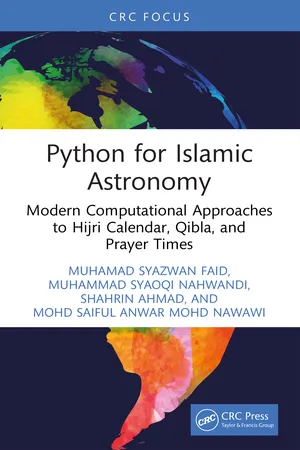
Python for Islamic Astronomy
Modern Computational Approaches to Hijri Calendar, Qibla, and Prayer Times
- English
- ePUB (mobile friendly)
- Available on iOS & Android
Python for Islamic Astronomy
Modern Computational Approaches to Hijri Calendar, Qibla, and Prayer Times
About this book
Python for Islamic Astronomy: Modern Computational Approaches to Hijri Calendar, Qibla, and Prayer Times responds to the urgent need to improve calculation accuracy and data visualizations in the field of Islamic Astronomy. This field is becoming increasingly complex, leading to mistakes in determining the beginning of the Hijri month, Qibla directions, and prayer times. This book offers a more precise approach by showing how the Python environment can be tailored for astronomical computations and how the mathematical principles behind Qiblah determination can be implemented through elegant Python algorithms. The guide provides detailed methodologies for calculating prayer times with astronomical precision, allowing for accurate scheduling regardless of global location. The book also delves into the science of moonsighting, helping readers learn to compute and analyze observation data critical for Islamic calendar determinations. Advanced visualization chapters bring these calculations to life through practical applications: develop your own Qiblah compass, create visual representations of the sun's position during prayer times, and generate detailed lunar crescent visibility charts to aid in moon-sighting efforts. Perfect for programmers interested in Islamic Astronomy, religious scholars embracing technology, or anyone seeking to understand the mathematical foundations behind these traditional practices, this guide bridges ancient wisdom with modern computational techniques, making complex astronomical calculations accessible through the power of Python.
Key Features:
- The first book to provide practical guidance for using Python, supplemented by an interactive coding website, to solve real-world problems in the field of Islamic Astronomy.
- Uses the latest and most-trusted methods in Islamic Astronomy, ensuring all calculations are accurate and based on well-recognized references.
- Includes visualizations that help readers understand key topics like Qibla direction, prayer time zones, and lunar crescent visibility, making the content practical and user-friendly.
Frequently asked questions
- Essential is ideal for learners and professionals who enjoy exploring a wide range of subjects. Access the Essential Library with 800,000+ trusted titles and best-sellers across business, personal growth, and the humanities. Includes unlimited reading time and Standard Read Aloud voice.
- Complete: Perfect for advanced learners and researchers needing full, unrestricted access. Unlock 1.4M+ books across hundreds of subjects, including academic and specialized titles. The Complete Plan also includes advanced features like Premium Read Aloud and Research Assistant.
Please note we cannot support devices running on iOS 13 and Android 7 or earlier. Learn more about using the app.
Information
Table of contents
- Cover
- Half-Title
- Title
- Copyright
- Contents
- Acknowledgments
- 1 Application of Islamic Astronomy for Muslim
- 2 Why Python Matters in Islamic Astronomy
- 3 Importance of Accuracy of Calculation
- 4 Setting up Python for Astronomical Calculations
- 5 Qiblah Calculation Using Python
- 6 Istiwa’ A’zam and Rashdul Qibla
- 7 Prayer Times Calculation
- 8 Moonsighting Observation Data Computation
- 9 Qiblah Compass Visualization
- 10 Sun Position during Prayer Times Visualization
- 11 Lunar Crescent Observation Data Visualization
- Conclusion
- References
- Index